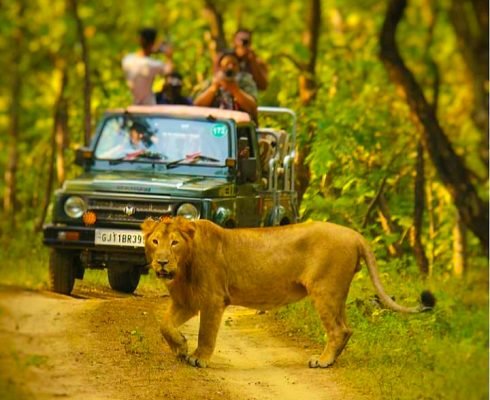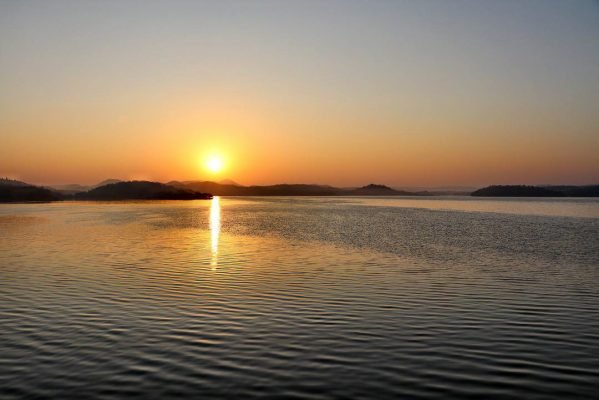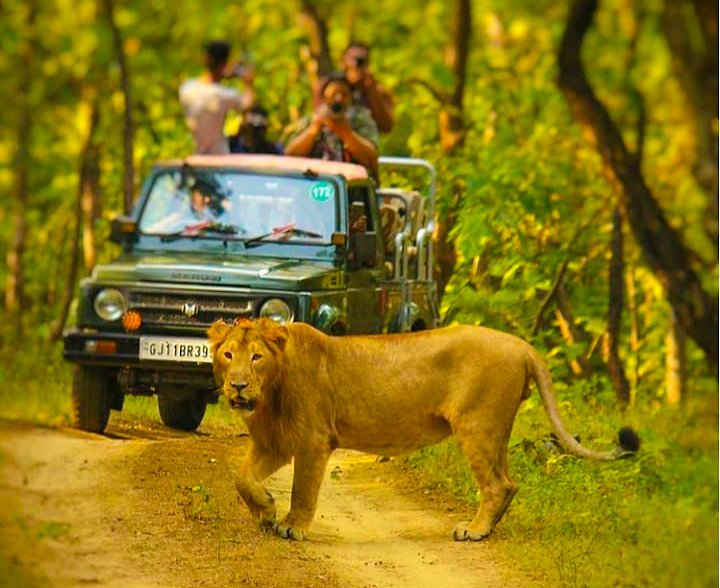Above 400 royal Asiatic lions. 300+ Leopards. 200+ bird varieties. 100+ mammals and reptiles. And much much more! Gir National park is a Jungle book story coming to life in an even more exciting way.
The 1412 square kilometres large park is exemplary in protecting what was gifted to us in au naturale. Conserving a great range of native species that would’ve otherwise fallen under the endangered list of animals.
What makes this park a must-visit is the presence of the wild Asiatic lion. Declared as a national park in 1975, this beautiful biodiversity hotspot is the ONLY PLACE in the entire world where these majestic beasts can be found wandering.
Spotting the fauna amidst the exotic floral blanket and deciduous forests is an exhilarating experience. Be it a safari or a short stroll around these regions, the arid ecoregion is going to leave you awestruck, and that’s guaranteed.
Location
Follow the compass to the southwest part of Gujarat towards the Sasan Gir village and you’ll be led to the Gir National Park. Located inland from the beaches of Diu, the park has a trail which has all the directions leading to the reception and orientation centre.
It’s easily accessible and at a considerable distance from many major cities in and around Gujarat,
Distance from Veraval – 69 km
Distance from Junagadh – 76 km
Distance from Porbandar – 179 km
Distance from Bhavnagar – 200 km
Distance from Ahmedabad – 325 km
Distance from Vadodara – 378 km
How to get here
By air :
There are several airports in and around, that connect Gir to the major cities. The closest one is Keshod airport and Rajkot airport. Which lie around 80 and 170 km from the park respectively. Both airports also have well-connected flights from Delhi, Mumbai, Chennai, Kolkata, and Ahmedabad.
Yet another convenient route remains the flight to Diu airport that is a 2-hour drive from the sanctuary. As your preference, you can choose a cab or bus service to facilitate your journey.
By train :
The nearest railway station is Junagadh, at a distance of 78 km from the park. There are frequent interstate trains, so taking a run through rails from cities like Ahmedabad and Rajkot would be quite easy.
From here the National Park is just a matter of a couple of hours drive. There are also shorter routes, which would lead you to the destination quicker but can get a little confusing.
Since it’s a tourist attraction that’s visited very often, there are many taxis and buses that’d run regularly to Sasan Gir from the station.
By road :
The GSRTC and Private AC buses are more opted for the journey. Even Though the interstate journey extends on for at least 3-6 hours, it’s accompanied by the scenic route.
There are several buses from major cities in Gujarat including Rajkot, Junagadh, Somnath, and Ahmedabad.
The most preferred route would be from Junagadh, as there’s always a bunch of localities who’d be going to the same destination from here. So if you’re travelling solo, this would be more like the base point from where you’d be guided to Sasan Gir.
Dropping points are mostly near the Forest Department’s Orientation Centre or at the Reception from where the visitors are supposed to acquire permits and passes.
Best time to visit
The park remains open for tourists from October to June ( shut during 16th June till 15th October).
While planning a visit to the National park, there are a few things that you might want to keep in mind,
- Periods when the wildlife is more active.
- Accessible periods to the park.
- Crowds and price hikes during weekends and holidays.
Considering these three factors the ideal period to visit would be during the months between December-March.
The temperature is ideal at a minimum of 10-20 degree Celsius. It also paves the way for a pleasant experience with many activities and explorations.
If photography is your calling, then summers would be your jackpot. The lions get out of their dens to get water and that sight makes it worth all the trouble.
Summers are avoided by many travellers due to heat waves which can get little crazy.
Monsoon is almost never preferred because the safari can get a little risky and may also go in vain as the animals do not get out of their shelters.
Opening hours and charges
The entry charges vary for Indian citizens and foreigners. The other charges that are accounted include those of photography, guide and safari.
Fees are as mentioned below,
Entry Fee
Indian visitors – Rs. 75
Foreign visitors – Rs. 100
Photography Fee – Rs. 100
Guide Service (4 hours) – Rs. 50
Safari Fee –
Indian citizens – Rs 4300 / Jeep (Up to 6 people in one Jeep)
Foreigners – Rs 13800 / Jeep (Up to 6 people in one Jeep)
For entering the park an entry permit has to be obtained. This can be taken from the Sinh Sadan Orientation Centre (the forest department orientation centre) that’s barely a 5-minute walk from the main gate.
The opening time of the centre is 7 AM to 11 AM in the morning, and from 3 PM to 5:30 PM in the evening. One pass can accommodate 6 people in total.
Another option that avoids all the fuss is the e-permit that can be taken through the online website. Additional charges apply if you prefer this and there are certain tips that might help you through it,
- Avoid the last-minute hassle and apply prior to your planned day of the visit. You can apply as before as three months itself and wait for it to get approved.
- The permit does not include fees for the Guide, Vehicle and camera. These have to be particularly paid at the park, so keep some cash in hand at all times.
- The permit requires valid proof while applying, so keep the soft copies of the photos of those travelling along with you, and certain government-approved IDs.
- Report to your point of safari at least half an hour earlier, to deal with last-minute formalities and procedures.
- The Gir Jungle Trail is the only refundable e-permit, all the other e-permits cannot be funded back.
- The charges that will be included are the Jeep & Driver (1700), Permit Charges (1000), Guide Charges (400), Online Payment Gateway Charges (200) and Service Charges and GST (1000).
Safari in Gir National Park is conducted for about 3 hours around the Gir Jungle Trail and falls under the timings of,
6:45 AM – 9:45 AM
8:30 AM – 11:30 AM
3:00 PM – 6:00 PM
Attractions
1) Explore the Gir Jungle Trail Safari

For all the adrenaline junkies and the cautious watchers, here’s a journey that covers it all up for you. The Gir Jungle is among the best Safari trails that show the untouched nature in all its glory.
While the risks that follow in a jungle are brought to you within the safety of the jeep, they’re not really sugar-coated.
The thrills are sure to get to you within the first five minutes of the safari, and you may want to look out for even the most unexpected sights here.
The safari is conducted in jeeps, gypsies, or canters with an experienced guide. They’d be present at all times and will be your eyes for the day. Be it to spot a wildly leaping jungle cat, easily camouflaged insect, Bonelli’s eagle soaring high above our heads or the showstopper Asiatic lion.
2) Marshes of the Crocodile Breeding Farm

While the park holds pride in being a world-renowned conservative sanctuary, there are several records they hold close to home.
Sheltering the largest number of marsh crocodiles in India, it’s a must-visit place. The idea in itself might sound quite intimidating, but it’s quite the opposite. It’s a welcoming breeze of air to understand the mighty creatures a bit better.
They’re rather seen as creatures from whom we borrowed their home. This is also reflected in their breeding and caring techniques.
It’s awe-strikingly fascinating to watch the shift from the playful looking baby crocs to the majestically scaled ones twisting and snaking their way through land and water.
3) Sunset at Kamleshwar Dam

If there’s a point in Gir with a charm that can be so gravitating, it’d be the Kamleshwar Dam. Built over the ethereal Hiran River, it’s a perfect viewpoint for watching the sunset into the horizons of the clear blue waters.
Located inside the park, you can always come across a few animals stopping by to refresh themselves.
Sun setting down slowly, small bridges decoratively placed, the expanse of green foliage, shadows of the wildlife cast over the reflective waters. The sight is something that’d be captured in your cameras and diary of memories forever.
It’s also among the pit stops with which you start the trip and end it.
4) Hot springs of Tulsi Shyam Temple

Walking up the 100 stone stairs, you’ll be led to one of the most beautiful and oldest temples around the state. The idol of Lord Krishna, which is worshipped here, is said to be about 3000 years old.
But what this temple is known even more for, is the presence of the three hot springs. Filled with waters that just tend to get warmer and warmer to the boiling point, it’s believed to contain healing and spiritual powers.
Being rich in natural sulphur, a lot of tourists are drawn here to take a dip and feel rejuvenated.
Another lesser-known fact about the temple is that the road attached to the temple is believed to have a gravity-defying phenomenon. Spend a good amount of time here exploring the architecture, myths, and aesthetics.
5) Walkthrough the exquisite tribal culture

Undoubtedly one of the most interesting things to do around Gir is a visit across the villages. The tribal settlements here come along with centuries-long tales and cultures. All those treasured and protected within the park.
The most prominent tribes around here are the pastoral community of Maldhari and the agricultural pockets of Siddis.
What’s more interesting is that the Siddis are the only African settlement in India, while in the rest parts of the country they’re pretty scattered. So not only would you be getting an insight to the Afro-Indian world, but you’d also be in for surprises with their differential take on absolutely everything under the sun.
It’s a beautiful cross-cultural tradition and everything from the clothing to cuisine would captivate you.
Tips
- For a better viewing experience, it’s always advised to carry a good pair of binoculars to the park.
- If you’re carrying a camera, make sure not to use the flash.
- Choose your clothing wisely and wear non-reflective and subtle colours that don’t draw unwanted attention from the wildlife.
- Private vehicles will only be allowed after several procedures, but it’s always better to opt for the safari with an experienced guide.
- Carry essentials such as water, cap/hats, sunscreen, and first aid.
- You’d be asked to stay in the vehicle with the guide at all times for safety reasons.
- The trail does not accommodate activities such as camping, hiking, picnicking. There are decent stay options around the park, be it resorts or boot camps.




